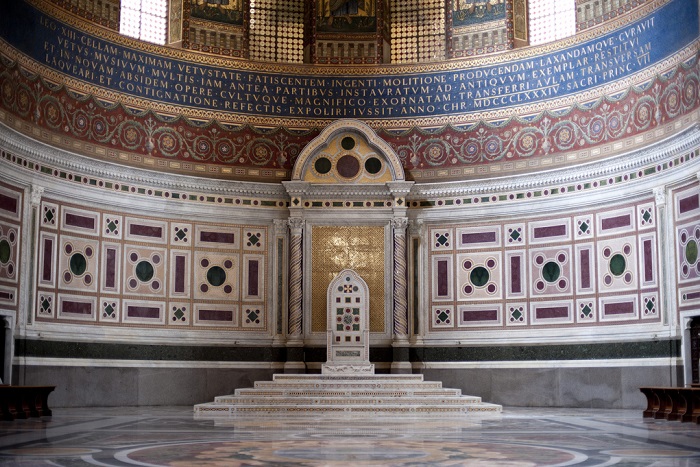
A bishop is a successor of the Apostles and the link between each Christian and the Church because the bishop is the chief priest of a local Church and the ultimate officiant of the Eucharist. Whilst the apostles’ ministry wasn’t confined to any geographical boundaries, a bishop’s ministry is tied to a certain location, i.e., his diocese. Bishop’s throne is an expression of the sacramental connection of the local Church and the bishop. It shouldn’t be confused with the bishop’s ambo (a low platform in the center of the nave used during a bishop’s service). A throne is a special chair in the altar of the main cathedral of the diocese.

Why did the throne come to be associated with the pontifical ministry? This connection can be traced back to the ante-Nicene period in the life of the Church. The Muratorian Canon (2nd century) mentions the see (sedes, lit. a place to sit on) of the Church of the City of Rome. Tertullian (early 3rd century) mentions “The Apostolic See” of Rome as a counterbalance to heretics (Tertull. De praescript. haer. 36). Christians started to attach symbolic meaning to the bishop’s throne under the influence of ancient Roman customs. The upper echelons of Roman officials were entitled to sitting on a special stool called curule seat. It was so prestigious that the officials who were allowed to sit on that stool were called curule magistrates. The magistrates were to sit on that stool while presiding over a court of law or while receiving visitors. The curule seat symbolized their imperium and authority. A bishop’s throne was also associated with a professor’s or a sage’s chair (that’s where the cathedra in universities comes from), and this image was used by the Savior himself, The scribes and the Pharisees sit in Moses’ seat (Μωσέως καθέδρας) (Matthew 23:2).
Soon after the throne became a symbol of bishop’s power and ministry, there appeared a special liturgical ritual for a newly-ordained bishop to ascend to his throne for the first time. There are mentions of this ritual in ancient manuscripts, e.g., in Canones Hippolyti (330s) and Apostolic Decrees (ca. 380). Enthronement in the Ancient Church wasn’t limited to the Patriarch; other bishops assumed their office by enthronement, too. The central ritual during an enthronement is when the newly-ordained bishop accedes to his throne and sits on it during liturgical readings. Enthronement can be found in one form or another in the liturgical traditions of both the East and the West.
Later, bishops were no longer ordained in their own dioceses. Their ordinations were held in patriarchal cathedrals. According to the most ancient Byzantine manuscripts of the Euchologion, the newly-ordained bishop would sit on the throne of the Patriarch and lead the celebration of the Eucharist. In the meantime, this ritual was found to be insufficient because it didn’t substitute the ascension of the bishop to his own throne. That was how a separate ritual of enthronement, held after the bishop’s arrival, in his diocese appeared.

We know how this ritual was organized in the Byzantine Church thanks to St. Symeon of Thessalonica († 1429). When the flock came to the cathedral, priests exclaimed the pre-Trisagion prayer followed by the Trisagion itself, essentially reproducing the initial part of the Liturgy to remind of the bishop’s ordination, which is usually held after the Trisagion. Then priests seated the bishop on his throne three times and proclaimed Axios! Immediately after that, the choir and the people sang Many Years, followed by the dismissal. After a festive meal, a bishop would climb a horse and ride around the city, which he was now in charge of. (See PG. 155. Col. 429).
Therefore, enthronement is an important and a very ancient ritual that has survived until today. This ritual points at the power and the special ministry of a bishop in his Church. Without a bishop, there is no Church; where the Church is, there Jesus Christ is, according to Saint Ignatius the God-Bearer. This truth is treasured by the Holy Orthodoxy. Let us thank God for our bishops who connect us with ties of love to the Apostles and the Lord God himself!



